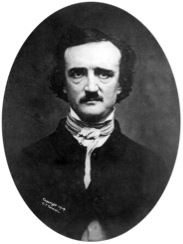93

Think of any horror, crime thriller, or tale of suspense these days, be it on film or in a book, and they all have their origins. The writers and creators of these subjects will often cite sources of inspiration, sometimes from personal experience, word of mouth, or exaggerated imaginative theory. However, more often than not, we have one man to thank for our beloved contemporary visions of the macabre…Edgar Allan Poe.
Born in Boston, Massachusetts on 19 January 1809, Poe was almost immediately thrust into the melancholy story that was his own life. Losing both his parents at around the age of three and being taken in by a well-to-do businessman from Richmond, Virginia, John Allan. Seemingly, all would become well for young Edgar as his never-legalized guardian saw to it that he attend the best schools to receive his education, even attending the University of Virginia for a time. Alas, Poe became addicted to gambling and similar vices, causing him to go into debt, which Allan refused to help him pay, therefore diffusing their relationship.
Growing up, Poe would be in the midst of spectacular and wicked events, including the war of 1812, the publication of Frankenstein, and the election of John Quincy Adams via the House of Representatives, surely playing into his already-darkening life. After succeeding in athletics at the academy of William Burke, Poe would go on to enlist in the United States Army in 1827 as well as publish his very first collection of poetry, Tamerlane and Other Poems. 1829 saw his second collection published, however, neither collection gained much attention, nor success. Poe was honorably discharged from the military and gained admittance to the academy at West Point for the United States Military, but only for a brief time before dismissal due to negligence in his duties and lack of support from Allan.
Poe then moved in with Maria Clemm, his aunt, in Baltimore, Maryland. During the early 1830’s, Edgar was able to establish himself more as a prolific writer, submitting his stories to magazines and other published articles, earning money and minor attention. He would later become editor for the Southern Literary Messenger, Gentleman’s Magazine, Broadway Journal, and Graham’s Magazine during the next decade. In this same time, Poe married Virginia, his aunt’s daughter/his cousin who was then only fourteen years old.
Now married and seemingly well off as editor for various products, Poe would write his most famous works, including “The Tell-Tale Heart”, “The Raven”, “The Cask of Amontillado” and his detective thrillers, including “The Murders in Rue Morgue”, utilizing his mind for suspense and chilling thrillers that gained him his truest publicity. However, Poe was also delving deeper into depression and had begun to become an alcoholic. Which would only become worse when his wife, Virginia, died of tuberculosis in 1847. Poe would continue to suffer from both depression and his alcoholism, creating trouble (and yet some inspiration) for his later writing.
In 1849, Poe was at his lowest point, and came to Baltimore, where he was found in a critical state, and died on 7 October 1849, due to brain damage and supposedly even rabies. Poe managed to escape the world with as much mystery and spine-tingling charm as only he would write in his stories, leaving him a legend more so after death than ever before. And to this day, Poe inspires all works of art in all genres from people of all ages, all over the world, and remains a Gothic, but intriguing, mark in American literature as well as history.
https://www.poets.org/poetsorg/poet/edgar-allan-poe
https://www.poetryfoundation.org/poems-and-poets/poets/detail/edgar-allan-poe
http://www.biography.com/people/edgar-allan-poe-9443160
Media Attributions
- poe
